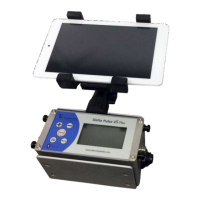
Do you have a question about the Teknoloji Ekibi Delta Pulse 3S Plus and is the answer not in the manual?
| Brand | Teknoloji Ekibi |
|---|---|
| Model | Delta Pulse 3S Plus |
| Category | Metal Detector |
| Language | English |
Delta Pulse 3S Plus offers ground balance technology to solve mineral problems effectively.
Delta Pulse 3S Plus has 6 working modes to suit different user styles and needs.
Detects ferrous-non ferrous metals, displaying values and categorizing items as worthless.
Features an ergonomic design and structure, integrating a tablet for a clutter-free experience.
High detection capability with patented One-Touch adjustment for very territorial and easy operation.
View live 3D shots from your computer with radiometer detectors for soil structure determination.
Offers 6 distinct modes for various soil types, mineral detection, and specialized fields.
Mode 1 allows immediate use without prior land setting, offering simplicity and convenience.
Mode 2 cuts off iron sounds, distinguishing it from other metals and preventing false positives.
Real ground balance mode with mono coil technology for effective mineral search without interference.
Allows manual adjustment of ground balance for mineral selection, offering precise control.
The central processing unit of the Delta Pulse 3S Plus metal detector.
Includes small coil and 1x1 coil for different detection depths and areas.
Ergonomic handle, battery, cable, and charger for detector operation and maintenance.
Sensor for advanced ground imaging and detection analysis.
Portable computer for displaying and analyzing detection data, often used with imaging modes.
Explanation of icons and indicators on the detector's screen for user understanding.
Distinguishes metal types based on numbers displayed, with precious metals showing higher values.
Shows metal perception strength, soil condition, and prompts for detector setting if needed.
Indicates battery charge and provides buttons for menu navigation and parameter adjustment.
Adjusts detector sensitivity, balancing precision with potential interference from high settings.
Details 6 different operating modes for various environments and detection needs.
Covers modes for general use, voice distinction, high mineral areas, and manual adjustments.
Combines 3D imaging and space detection, observing metal shapes upwards and downwards.
Explains settings for filter coefficient, ground tone, soil speed, and detection levels.
Steps for preparing coils, attaching them to the arm, and wrapping cables for use.
Instructions for wearing the battery and detector unit for comfortable operation.
Procedure for installing coil and battery connectors for proper detector function.
Advises against using the detector near high voltage environments or electromagnetic interference.
Procedure for using the small coil, including pressing the tune button and initial setup.
Step-by-step guides for tuning the detector in Modes 4 and 5 for accurate ground balancing.
Recommendation to use ground sound for obtaining high efficiency during detection.
Indicates when soil setting needs re-evaluation based on battery indicator or exclamation marks.
Guidance for using large coils (frame, kite), noting they are often for two users.
Covers battery charge, metal presence, environment, high voltage, and coil/cable care.
Tips on coil movement, tuning, and handling interference in different modes.
Steps for using 3D imaging, including preparing the detector and activating the tablet software.
Connecting the detector to the tablet via Bluetooth for data transfer.
Configuring display settings and selecting the correct device type in the 3D viewer program.
Entering field length, width, and step size for accurate data capture.
Guidance on sampling paths, button presses for data capture, and image display.
Alerts for direction changes and how to manage them during data capture.
Importance of maintaining correct sensor direction (North/South) and angle for accurate readings.
Notes on sensor and battery installation, and detector operation during 3D viewing.
Steps to open the tablet and the TE 3D Viewer program for data analysis.
Establishing Bluetooth connection between the tablet and the detector for gradiometer data.
Accessing 3D adjustments and selecting Gradiometer as the device type in the software.
Performing capture and entering step size for sample calculations.
Ensuring sensor position, radiometer position, and coil diameter correctness for accurate data.
Explanation of various filters for data processing, including depth, surface, and separation filters.
Understanding the color valence scale and how colors represent received data and metal values.
Examples of interpreting data for mineral detection, soil anomalies, and different metal types.
Visual representation of gradiometer readings for different area types.
Images showing detection results for small metals using the metal detector.
Visual output of gradiometer readings specifically for iron detection.
Flexibility to adjust colors in the color scale as per user preference.
Confirmation that displayed data and pictures are not imaginary and can be accessed by customers.